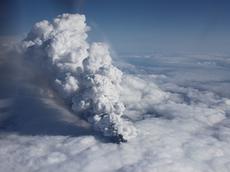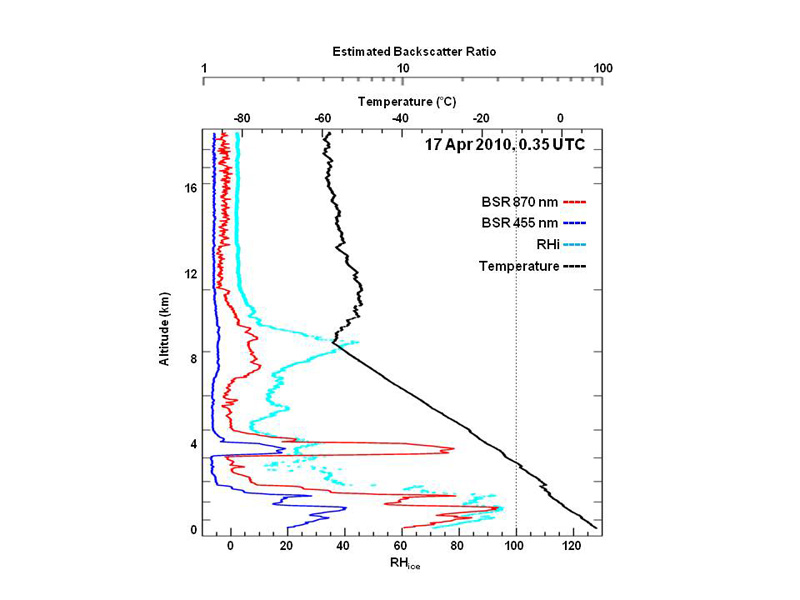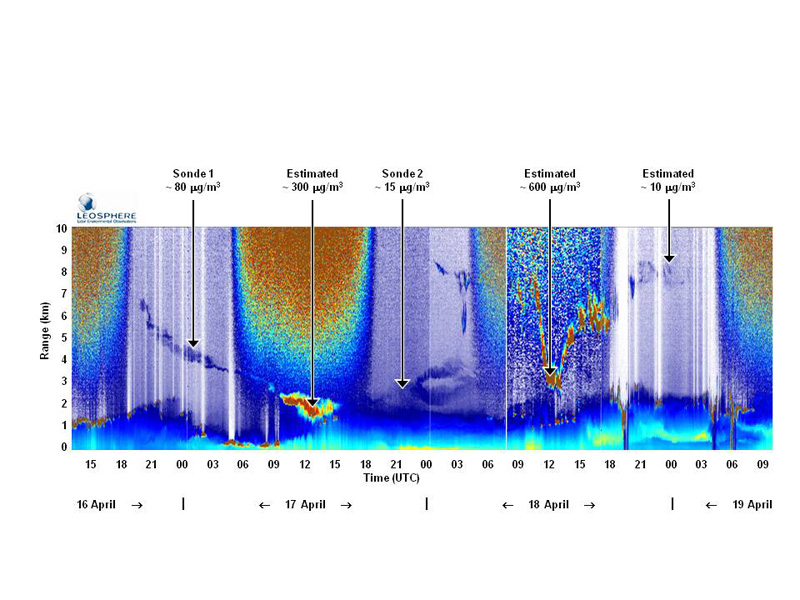Tests support flight ban
Last weekend, using state-of-the-art measuring technology from ETH Zurich scientists measured the extent to which the atmosphere was affected by the volcanic eruption in Iceland directly in the ash cloud. The results suggest that the flight ban was justified. In the meantime, the volcano has settled down, but a change in the magma composition has generated speculations.

The air travel situation has improved: after the eruption of Iceland’s volcano Eyjafjallajökull paralyzed air traffic for several days, the aircraft have now been cleared for take-off again. The initial analyses of the measurement data collected over the weekend by ETH Zurich’s Institute for Atmospheric and Climate Science using weather balloons equipped with special sondes and a so-called aerosol lidar (see ETH Life article from April 19 2010) now confirm that closing the airspace over most of Europe was a justifyable and by no means excessive precautionary measure: on the night of April 16 and 17, one of the balloon sondes recorded about 80 micrograms of volcanic particles per cubic meter of air at an altitude of four kilometers (approx. 2.5 miles). The particles had a mean diameter of approximately 3 micrometers, and on Sunday the concentration even reached 600 micrograms per cubic meter. “That’s very high”, says Thomas Peter, a professor at ETH Zurich’s Institute for Atmospheric and Climate Science who spearheaded the quickly coordinated measurements at ETH. Just to put it in perspective, the average annual particulate concentration in Zurich is around 50 micrograms per cubic meter.
Flight ban logical consequence
As far as Peter is concerned, the flight ban was the only logical course of action: “For a decision to be made on a sound scientific and technical basis aircraft engines would have to be tested to establish what concentration of volcanic particles they could withstand; without this kind of threshold, it’s just too risky.”
Peter and his team measured the concentration using balloons that were released into the atmosphere from the roof of the institute and entered the aerosol cloud. The balloons had been equipped with globally unique “backscatter sondes” developed at ETH Zurich, which emit light on two wavelengths. The light is scattered back by the ash glass particles and measured by the probe, which is no bigger than a cigarette packet. The analysis of the backscattered light enables the scientists to gauge the number density and size of the aerosol particles. The product of these two figures then yields the concentration of ash glass particles in micrograms per cubic meters.
The high concentration values derived immediately triggered much debate among Peter’s fellow scientists. He allowed for an error of plus/minus 30 percent; otherwise, he is positive that the measurements and analyses are correct.
Will the volcano settle down?
It remains to be seen whether or not this was all merely a prelude, or whether Eyjafjallajökull will also cause the neighboring volcano of Katla to become active in a repeat of what happened almost 200 years ago (1821-1823). For the time being at least, there are no signs that support this. However, for volcanologists in Iceland and the petrologist Peter Ulmer, an adjunct professor at ETH Zurich’s Institute of Geochemistry and Petrology, the fact that the magma composition has changed since the beginning of the eruption in March is highly fascinating. The volcano initially discharged basaltic magma originating from a depth of at least ten kilometers into an ice-free area at the surface; however, the eruption gradually moved under the ice-covered section of the volcano; as the hot magma came into contact with the meltwater, an explosive, so-called phreatomagmatic eruption ensued. The pressurized water vapor formed in the process blasted the ash, which was made up of glass particles, several kilometers up into the air as a fine dust. These special circumstances also triggered the worst disruptions to air traffic across North-Western Europe ever witnessed in the history of jet aviation.
By the time the volcano began to erupt beneath the glacier, its magma composition had changed; instead of basaltic magma, since April 14 Eyjafjallajökull has been pouring out magma with a higher proportion of silicate. The critical thing here is that when magma attains a silicon content of 56 weight percent or a magnesium content of less than 4 weight percent, it can spontaneously explode, without the involvement of water from outside. “The interesting thing is that the magma composition now observed is located on a mixing line between the composition of the Eyjafjallajökull eruption of 1821 and the Katla eruption in 1918”, says Ulmer. Presumably, the magma rising from the depths has blended with the “magma residues” of a higher level magma chamber from the 1821 eruption.
Worst-case scenario
For the time being, there is no indication that the volcano will become spontaneously explosive, stresses Ulmer. But should the magma develop in this direction, or the higher acidic magma reservoirs of Katla heat up and become activated via the Eyjafjallajökull’s rising magma, it could trigger the most formidable kind of eruption of them all: a plinian eruption.
During a plinian eruption gas, dust, ash and pumice is blown high into the atmosphere, causing a rain of ash that can last for days. After a while, this “eruption column” collapses in on itself, producing what is known as a ‘pyroclastic flow’, where hot gases, ash and clots of lava pour down the mountain like an avalanche. Due to the high gas content, however, the mixture moves considerably faster than typical avalanches and mudslides, reaching speeds of several hundred kilometers per hour and obliterating everything in its path. It is named after Pliny the Younger, who in letters to the historian Tacitus described the devastating eruption of Mount Vesuvius that razed Pompeii to the ground in 79 AD. Compared with a plinian eruption, the current situation is mere child’s play, claims Ulmer.
So far, the volcano has only extruded about 140 million cubic meters of volcanic ash - one tenth of the Montserrat eruption (Antilles, 1997) or one hundredth of the Pinatubo eruption (Philippines, 1991), stresses Ulmer. Apart from the danger to the Icelandic population, a plinian eruption could last weeks or even months.
Iceland
Iceland is located on the Mid-Atlantic Ridge. The edges of the American and Eurasian tectonic plates run straight through the island, moving apart at a rate of about two centimeters a year; moreover, the island is also situated on top of a so-called mantle plume, where hot matter is pumped from deep inside the earth’s mantle towards the earth’s surface. This is more than likely one of the reasons why acidic, silicate-rich rock is formed in Iceland in addition to the typical basaltic rock produced on the Mid-Atlantic Ridge. Magma therefore does not only rise to the surface as fluid basaltic lava; silicate-rich magma is viscous and rich in gases; if these heat up and become pressurized, the viscid mass explodes to the surface. Iceland thus boasts a comprehensive volcanic spectrum: from simple lava flow all the way up to plinian eruptions.









READER COMMENTS